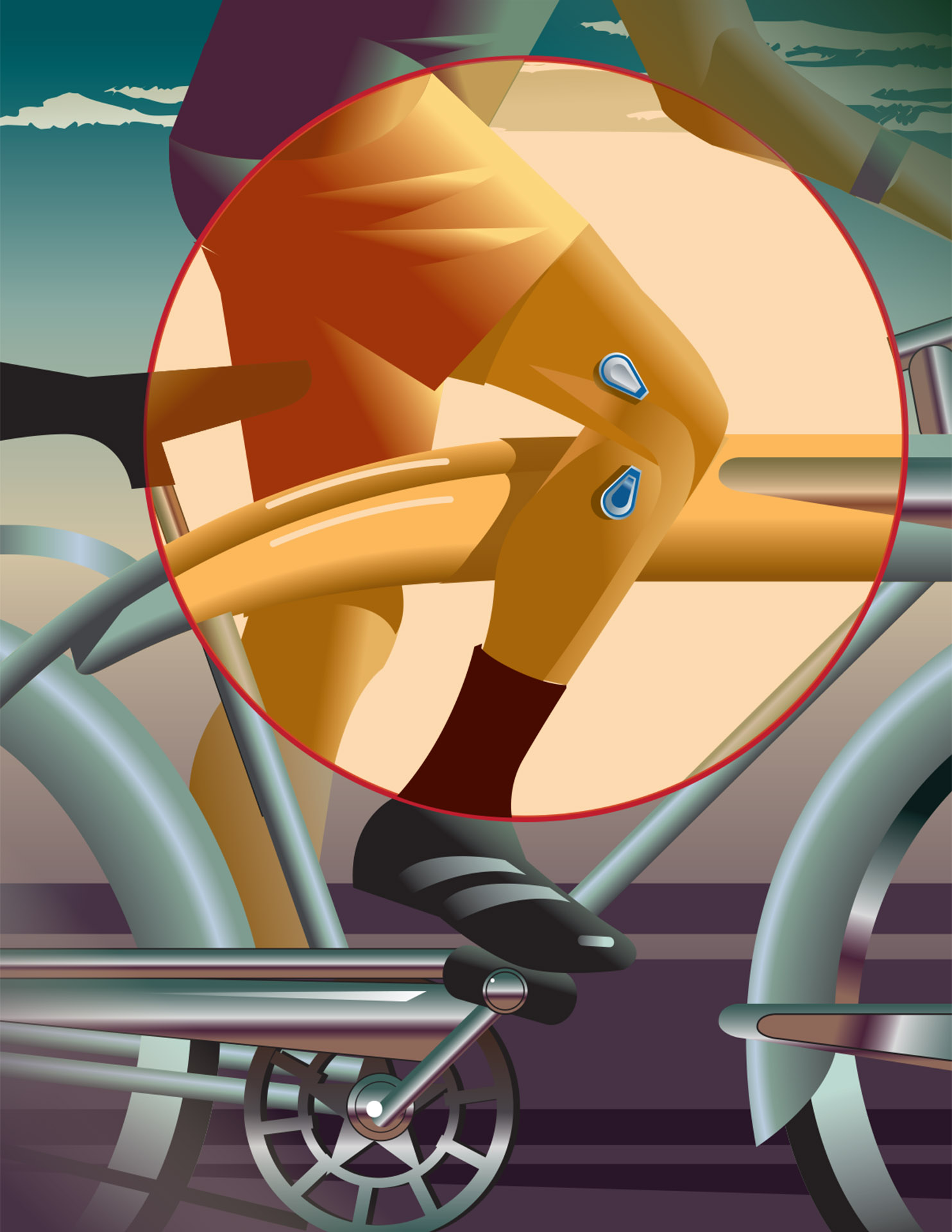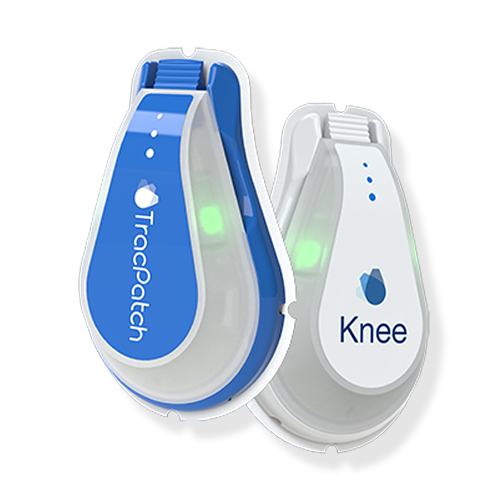Health Watch
Wearable devices are providing more accurate information about people’s day-to-day activities
By Josh Baxt
Illustrations by John Mattos

A
pple Watches, Fitbits and other wearable devices are becoming ubiquitous, helping people measure their exercise, sleep and other health-related metrics. Health researchers are now embracing similar technologies to gather more accurate information about patients’ day-to-day activities.
“When I give a patient a survey about their physical activity, the responses could be biased,” said Tracy Crane, Ph.D., co-leader of the Cancer Control Research Program and director of lifestyle medicine and digital health for survivorship at Sylvester Comprehensive Cancer Center, and associate professor of medicine in the Division of Medical Oncology. “With wearables, we can passively gather data, and that takes away some bias. We can gather patient data in an unobtrusive way.”
However, wearables are a relatively new technology, and Dr. Crane and colleagues are still figuring out how best to integrate these consumer-generated health data into their work. Even choosing a device can be tricky. While Fitbits and Apple Watches are widely used, Dr. Crane opts for the addition of an ActiGraph watch, an accelerometer that is the current gold standard for measuring daily activity. Sometimes the results can be surprising.
“My goal is to figure out how these devices and sensors can help us stratify care.”
“People don’t know what they don’t know,” Dr. Crane said. “They may think they exercise at a moderate intensity three times a week, but in reality, when we place a device on them, they are often overestimating or sometimes even underestimating their activity.”
Part of Dr. Crane’s job is assessing some of the myths associated with physical activity. One of these is “10,000 steps per day,” which posits that people should walk 10,000 steps for good health. But this idea doesn’t seem to be based on evidence. In fact, nobody knows for sure where it came from.
One recent study tracked it down to a Japanese company that marketed a pedometer in the 1960s. The pedometer was originally called manpo-kei, which translates to “10,000-step meter” in English, and the number may have been selected because the Japanese character for 10,000 resembles a person walking. Several studies have since found that there is nothing special about 10,000 steps per day. The bottom line is that people should aim to move more every day. Recent research suggests that postmenopausal women could see significant health benefits with far fewer steps — 4,400 steps per day was associated with a 40% reduction in premature death.
Benchmarking Activity Levels
Dr. Crane expects that data from ActiGraphs and other devices can help benchmark the most appropriate activity levels for different groups of people. This will help clinicians better understand when individual patients are on the right track or when they might need a little nudge.
“My goal is to figure out how these devices and sensors can help us stratify care,” Dr. Crane said. “We want to know when to intervene, and with which patients, for better results.”
One clinical example is a type of nerve damage called chemotherapy-induced peripheral neuropathy. Neuropathy can cause pain, tingling and numbness in the hands, feet and other parts of the body. This discomfort can create a slippery slope by limiting a patient’s movement, and inactivity may worsen the neuropathy. Dr. Crane’s team is using wearable devices to learn more about ovarian cancer patients, who are at high risk for experiencing neuropathy, in order to identify better ways to intervene.
“Chemotherapy-induced peripheral neuropathy is very painful and causes people to lose functionality,” Dr. Crane explained, “but we don’t understand the natural trajectory over time. When does neuropathy start? Are there risk factors associated for who develops it? By placing devices on patients as they start treatment, we expect to see dips in daily activity and physical function. We can combine these daily patient-generated data with traditional neuropathy scales and determine if we see any trends.”
Pinpointing When to Intervene
From there, the team can begin to understand chemotherapy-induced peripheral neuropathy progression and pinpoint the right moment to intervene. If a patient is moving less, due to instability when walking, they might suggest walking poles. The hope is that more activity will mitigate neuropathy.
“We want to know when to intervene, and with which patients, for better results.”
Dr. Crane and colleagues are also exploring how to help patients receiving intensive therapies for hematologic malignancies and sarcomas. Oncologists need to track these patients’ white blood cell counts, temperature and other issues to better manage adverse events and side effects.
“These treatments can cause significant adverse events, such that patients may need to stay in the hospital in order for us to monitor them,” Dr. Crane said. “Now, we are exploring remote sensors, which could allow us to send people home with a device that reads their white cell counts, the way a glucometer reads glucose levels for people with diabetes, in addition to their temperature and daily activity. We are hoping to bring some of the inpatient monitoring to people’s homes, with a long-term goal of generating predictive algorithms using these patient-generated data to provide precision oncology care.”
Greater Flexibility for Knee Replacements
A wearable device gives patients the option of physical therapy at home

Product photographs courtesy of TracPatch Health

T
raditionally, after undergoing a full knee replacement, patients spend several weeks in physical therapy to regain their strength and range of motion. The COVID-19 pandemic upended that routine: As people went on lockdown, formal PT was simply out of the question. But University of Miami Health System clinicians, led by orthopedic surgeon Victor H. Hernandez, M.D., saw an opportunity. Dr. Hernandez had been working since 2017 with a recovery device for personalized rehabilitation. With this wearable device, called the TracPatch, patients can self-direct their PT regimen while being monitored by their clinical team and having direct contact with their physician.
Developed by TracPatch Health, the device has two pieces, attached above and below the patient’s knee, that contain an accelerometer (to measure linear motion), a gyrometer (to measure circular motion) and other sensors. The device collects data on overall movement, range of motion and stability, as well as the temperature at the surgical site (to monitor for possible infection). The TracPatch is constantly communicating with an app on the patient’s cellphone, which uploads the data to a secure, cloud-based portal that clinicians can access as needed. In addition, the patient can text and send pictures to their care team through the app, as well as fill out patient forms.
Weekly Goals and Reports
“Every week, we give the patient goals in terms of recovery,” Dr. Hernandez said. “If the patient achieves their goals, I don’t need to see them. But if they fall behind, the device flags me. I can then talk to the patient to see what’s going on, make pain management or other adjustments, and help them get more exercise, range of motion and rapid recovery.” Dr. Hernandez had been using the device for a few years, but it didn’t gain traction until COVID. Since then, positive word of mouth has made the TracPatch a popular PT alternative. “Patients don’t necessarily want to go to physical therapy,” he said. “They’ve learned about the TracPatch from other patients, and they want to have that option to perform their recovery under direct guidance at home.”
“With TracPatch, patients can self-direct their PT regimen while being monitored by their clinical team.”
Dr. Hernandez and colleagues have conducted a proof-of-concept clinical trial with 450 patients and are collecting data from a randomized study to learn more about the TracPatch’s impact on patient outcomes. In addition, the team is working on devices for other joints.
“Right now, we are working with the team at TracPatch Health to develop devices for hip, shoulder replacements and back surgeries,” Dr. Hernandez said. “It’s a little more challenging for the other joints because they require different ways to measure motion, but I think within the next couple of years we are going to come up with shoulder and spine instruments.” ![]()



